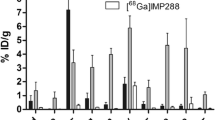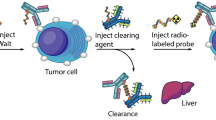Abstract
Purpose
Our objective was to study the cellular and nuclear uptake of 123I-mouse IgG (123I-mIgG) linked to peptides [GRKKRRQRRRPPQGYGC] harbouring the membrane-translocating and nuclear import sequences of HIV-1 tat protein.
Methods
Carbohydrates on mIgG were oxidized by NaIO4, then reacted with a 40-fold excess of peptides. Displacement of binding of anti-mouse IgG (Fab specific; α-mFab) to 123I-mIgG by tat-mIgG or mIgG was compared. Internalization and nuclear translocation of 123I-tat-mIgG in MDA-MB-468, MDA-MB-231 or MCF-7 breast cancer cells were measured. The immunoreactivity of imported tat-mIgG was evaluated by measuring binding of 123I-α-mFab to cell lysate and by displacement of binding of 123I-mIgG to α-mFab by cell lysate. Biodistribution and nuclear uptake of 123I-tat-mIgG, 123I-mIgG and 123I-tat were compared in mice bearing s.c. MDA-MB-468 tumours.
Results
There was a 15-fold decrease in affinity of α-mFab for tat-mIgG compared with mIgG. Internalized radioactivity imported into the nucleus for 123I-tat-mIgG in MDA-MB-468, MDA-MB-231 and MCF-7 cells was 61.5±0.6%, 60.3±3.6% and 64.7±1.0%, respectively. The binding of 123I-α-mFab to lysate from MDA-MB-468 cells importing tat-mIgG was 17-fold higher than that for cells not exposed to tat-mIgG. Imported tat-mIgG competed with tat-mIgG for displacement of binding of 123I-mIgG to α-mFab. Conjugation of mIgG to tat peptides did not change tissue distribution. Nuclear localization for 123I-tat-mIgG in MDA-MB-468 tumours was 28.1±5.6%, and for liver, spleen and kidneys it was 41.7±2.7%, 13.8±0.8% and 36.9±3.3%, respectively.
Conclusion
123I-tat-mIgG radioimunoconjugates suggest a route to the design of radiopharmaceuticals exploiting intracellular and nuclear epitopes.







Similar content being viewed by others
References
Divgi CR. Status of radiolabeled monoclonal antibodies for diagnosis and therapy of cancer. Oncology 1996;10(6):939–53
Urbain JL. Oncogenes, cancer and imaging. J Nucl Med 1999;40(3):498–504
Welt S, Mattes MJ, Grando R, Thomson TM, Leonard RW, Zanzonico PB, et al. Monoclonal antibody to an intracellular antigen images human melanoma transplants in nu/nu mice. Proc Natl Acad Sci U S A 1987;84(12):4200–4
Khaw BA, Fallon JJ, Beller GA, Haber E. Specificity of localization of myosin-specific antibody fragments in experimental myocardial infarction. Histologic, histochemical, autoradiographic and scintigraphic studies. Circulation 1979;60(7):1527–31
Cohen PA, Mani JC, Lane DP. Characterization of a new intrabody directed against the N-terminal region of human p53. Oncogene 1998;17(19):2445–56
Arnheiter H, Haller O. Antiviral state against influenza virus neutralized by microinjection of antibodies to interferon-induced Mx proteins. EMBO J 1988;7(5):1315–20
Chakrabarti R, Wylie DE, Schuster SM. Transfer of monoclonal antibodies into mammalian cells by electroporation. J Biol Chem 1989;264(26):15494–500
Park JW, Hong K, Kirpotin DB, Colbern G, Shalaby R, Baselga J, et al. Anti-HER2 immunoliposomes: enhanced efficacy attributable to targeted delivery. Clin Cancer Res 2002;8(4):1172–81
Richard JP, Melikov K, Vives E, Ramos C, Verbeure B, Gait MJ, et al. Cell-penetrating peptides. A reevaluation of the mechanism of cellular uptake. J Biol Chem 2003;278(1):585–90
Derossi D, Calvet S, Trembleau A, Brunissen A, Chassaing G, Prochiantz A. Cell internalization of the third helix of the Antennapedia homeodomain is receptor-independent. J Biol Chem 1996;271(30):18188–93
Elliott G, O’Hare P. Intercellular trafficking and protein delivery by a herpesvirus structural protein. Cell 1997;88(2):223–33
Kubota S, Siomi H, Satoh T, Endo S, Maki M, Hatanaka M. Functional similarity of HIV-I rev and HTLV-I rex proteins: identification of a new nucleolar-targeting signal in rev protein. Biochem Biophys Res Commun 1989;162(3):963–70
Green M, Loewenstein PM. Autonomous functional domains of chemically synthesized human immunodeficiency virus tat trans-activator protein. Cell 1988;55(6):1179–88
Frankel AD, Pabo CO. Cellular uptake of the tat protein from human immunodeficiency virus. Cell 1988;55(6):1189–93
Shibagaki N, Udey MC. Dendritic cells transduced with protein antigens induce cytotoxic lymphocytes and elicit antitumor immunity. J Immunol 2002;168(5):2393–401
Pooga M, Soomets U, Hallbrink M, Valkna A, Saar K, Rezaeik K, et al. Cell penetrating PNA constructs regulate galanin receptor levels and modify pain transmission in vivo. Nat Biotechnol 1998;16(9):857–61
Astriab-Fisher A, Sergueev D, Fisher M, Shaw BR, Juliano RL. Conjugates of antisense oligonucleotides with the Tat and antennapedia cell-penetrating peptides: effects on cellular uptake, binding to target sequences, and biologic actions. Pharm Res 2002;19(6):744–54
Schwarze SR, Ho A, Vocera-Akbani A, Dowdy SF. In vivo protein transduction: delivery of a biologically active protein into the mouse. Science 1999;285(5433):1569–72
Lewin M, Carlesso N, Tung CH, Tang XW, Cory D, Scadden DT, et al. Tat peptide-derivatized magnetic nanoparticles allow in vivo tracking and recovery of progenitor cells. Nat Biotechnol 2000;18(4):410–4
Torchilin VP, Rammohan R, Weissig V, Levchenko TS. TAT peptide on the surface of liposomes affords their efficient intracellular delivery even at low temperature and in the presence of metabolic inhibitors. Proc Natl Acad Sci U S A 2001;98(15):8786–91
Eguchi A, Akuta T, Okuyama H, Senda T, Yokoi H, Inokuchi H, et al. Protein transduction domain of HIV-1 Tat protein promotes efficient delivery of DNA into mammalian cells. J Biol Chem 2001;276(28):26204–10
Gratton JP, Yu J, Griffith JW, Babbitt RW, Scotland RS, Hickey R, et al. Cell-permeable peptides improve cellular uptake and therapeutic gene delivery of replication-deficient viruses in cells and in vivo. Nat Med 2003;9(3):357–62
Vives E, Brodin P, Lebleu B. A truncated HIV-1 Tat protein basic domain rapidly translocates through the plasma membrane and accumulates in the cell nucleus. J Biol Chem 1997;272(25):16010–7
Nitin N, LaConte LEW, Zurkiya O, Hu X, Bao G. Functionalization and peptide-based delivery of magnetic nanoparticles as an intracellular MRI contrast agent. J Biol Inorg Chem 2004;9(6):706–12
Zeng YX, el-Deiry WS. Regulation of p21WAF1/CIP1 expression by p53-independent pathways. Oncogene 1996;12(7):1557–64
Awwad M, Strome PG, Gilman SC, Axelrod HR. Modification of monoclonal antibody carbohydrates by oxidation, conjugation, or deoxymannojirimycin does not interfere with antibody effector functions. Cancer Immunol Immunother 1994;38(1):23–30
King TP, Zhao SW, Lam T. Preparation of protein conjugates via intermolecular hydrazone linkage. Biochemistry 1986;25(19):5774–9
Saha GB. Fundamentals of nuclear pharmacy, 3rd edn. New York Berlin Heidelberg: Springer; 1992
Whiteman M, Armstrong JS, Cheung NS, Siau JL, Rose P, Schantz JT, et al. Peroxynitrite mediates calcium-dependent mitochondrial dysfunction and cell death via activation of calpains. FASEB J 2004;18(12):1395–7
Futaki S, Suzuki T, Ohashi W, Yagami T, Tanaka S, Ueda K, et al. Arginine-rich peptides. An abundant source of membrane-permeable peptides having potential as carriers for intracellular protein delivery. J Biol Chem 2001;276(8):5836–40
Tyagi M, Rusnati M, Presta M, Giacca M. Internalization of HIV-1 tat requires cell surface heparan sulfate proteoglycans. J Biol Chem 2001;276(5):3254–61
Hu M, Wang J, Chen P, Vallis K, Reilly RM. Investigation of p21WAF-1/CIP-1 as a potential target for molecular imaging of anti-tumour response in breast cancer. Eur J Nucl Med Mol Imaging 2002;29 Suppl 1:s378
Rodwell JD, Alvarez VL, Lee C, Lopes AD, Goers JW, King HD, et al. Site-specific covalent modification of monoclonal antibodies: in vitro and in vivo evaluations. Proc Natl Acad Sci U S A 1986;83(8):2632–6
Alvarez VL, Lopes AD, Lee C, Rodwell JD, McKearn TJ. Studies of 111indium-labeled antibodies using nude mouse xenograft systems. In: Rodwell JD, editor. Antibody-mediated delivery systems. New York: Dekker; 1988. p. 283–315
Futaki S, Nakase I, Suzuki T, Youjun Z, Sugirura Y. Translocation of branched-chain arginine peptides through cell membranes: flexibility in the spatial disposition of positive charges in membrane-permeable peptides. Biochemistry 2002;41(25):7925–30
Weis K. Importins and exportins: how to get in and out of the nucleus. Trends Biochem Sci 1998;23(5):185–9
Sheshberadaran H, Payne LG. Protein antigen-monoclonal antibody contact sites investigated by limited proteolysis of monoclonal antibody-bound antigen: protein “footprinting”. Proc Natl Acad Sci U S A 1988;85(1):1–5
Acknowledgements
This project was supported by grants from the Cancer Research Society Inc. and the Breast Cancer Society of Canada to R.M.R. and a Predoctoral Traineeship Award from the U.S. Army Breast Cancer Research Program (DAMD 17-02-1-0598) to M.H. Parts of this manuscript were presented at the Radiopharmaceutical Science Council Young Investigator’s Award Symposium at the 51st Annual Meeting of the Society of Nuclear Medicine in Philadelphia, PA, June 20–23, 2004.
Author information
Authors and Affiliations
Corresponding author
Rights and permissions
About this article
Cite this article
Hu, M., Chen, P., Wang, J. et al. Site-specific conjugation of HIV-1 tat peptides to IgG: a potential route to construct radioimmunoconjugates for targeting intracellular and nuclear epitopes in cancer. Eur J Nucl Med Mol Imaging 33, 301–310 (2006). https://doi.org/10.1007/s00259-005-1908-7
Received:
Accepted:
Published:
Issue Date:
DOI: https://doi.org/10.1007/s00259-005-1908-7




